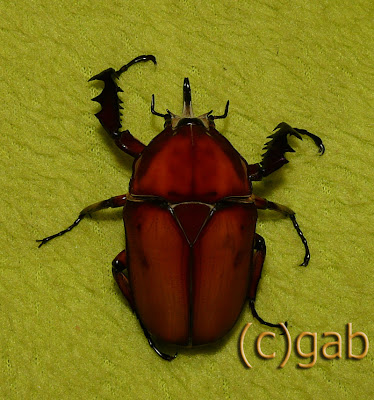
Short description:
The beetle Mecynorrhina polyphemus confluens belongs to the family Scarabaeidae, and the subfamily Cetoniinae. The habitat of the species is Central Africa (Zaire, Central African Rep., Ivory Coast, Gabon, Uganda, Ghana). The male and the female beetle has different characteristics, the male has a distinctive head horn and has velvety finish on the elytra, on the other hand the female has a subtle glow and lacks any head horns. Its colour is green with yellowish white spots. Its size is about 45-70 mm.
Raring:
This beetle is strongly diurnal, prefers hot temperatures, bright light and relatively high humidity (60-80%). For a smaller breeding group (2-3 males, 5-6 females) an
50 x 50 x 60-70(height) cm terrarium is suitable.
50 x 50 x 60-70(height) cm terrarium is suitable.
You use the general substrate for flower beetles, consisting of decaying wood and leaf (the last one should be about the 50-80% of the whole substrate). You can use about 5% of peat or soil, which has an important role for the females in laying eggs and for the larvae to make the pupal chambers.
Feeding:
The beetles eat fuit: banana, apple, pear, strawberry, cherry, watermelon, seasonal fruits... If any friut is left remove it from the terrarium to avoid rotting, molding and the appearance of mites. Some breeders feed the beetles with beetle jelly, which makes their life expectancy higher, helps the females to lay more eggs, keeps you free of annoing sciarid flies. I don't have any experience with this sort of food.
Breeding:
This beetle is quite productive, you can expect 30-40 eggs per female. The imago lives about 3-4, sometimes even 6 months.This depends on the temperature, the feeding and the size of the beetle. In a cooler environment (18-20 C) they live longer, lay less eggs thogh. The female lays its eggs one by one, with the size about 3 mm. The time until it transforms into an adult beetle takes about 1 year.

Rövid ismertető:
A Mecynorrhina polyphemus confluens a Scarabaeidae családba, azon belül az virágbogarak (Cetoniidae) alcsaládba tartozik.
A faj élőhelye Közép Afrika (Zaire, Közép-Afrikai Közt., Elefántcsontpart, Gabon, Uganda, Gána). A nemek között ivari dimorfizmus figyelhető meg, a hím jellegzetes villás végű kinövést, valamint két kisebb tüskét visel
a fejen. A bogár színe zöld, vajszínű foltokkal. A hím testét bársonyos szőr borítja (nevére utal), míg a nőstény csupasz. Mérete 45-70 mm.
Tartása:
Erősen nappali életmódú faj, szereti a meleget, és az erős megvilágítást, illetve a magasabb páratartalmat (60-80%). Egy kisebb tenyészcsoport számára (2-3 hím, 5-6 nősténnyel) elegendő egy 50 x 50 cm alapterületű, 60-70 cm magas terrárium.
A terráriumba tegyünk rózsabogarak számára használt tápkeveréket, melynek fő alkotóeleme a hullott falevél és fakorhadék, mindkettő apróra zúzott állapotban, előbbi legyen túlsúlyban (50-80%-a a tápkeveréknek). Ezen kívül még kb.5%-nyi tőzeget adjunk a keverékünkhöz, mely a peterakásnál, ill. a bábkamra építésénél játszik fontos szerepet.
Táplálás:
A bogarak gyümölcsöt esznek: alma, , körte, banán, eper, cseresznye, dinnye, az éppen szezonális gyümölcsök... Az el nem fogyasztott táplálékot ki kell venni, hogy elkerüljük a rothadást és penészedést, ill. az atkásodást. Egyesek ún. bogárzselével etetik az állataikat, mely állítólag összetételéből kifolyólag nagyobb petemennyiséghez, hosszabb élettartamhoz segíti hozzá a bogarakat, ill. elkerülhetjük vele a muslincák megjelenését. Nekem ezzel kapcsolatban nincs tapasztalatom.
Szaporítás:
Szapora faj, nőstényenként 30-40 lárvával nyugodtan számolhatunk. A kifejlett bogarak, imágók élettartama 3-4 hónap, de alkalmanként ez akár 6 hónap is lehet. Ez függ a tartási hőmérséklettől, táplálástól, testmérettől is. A hűvösebb helyen, 18-20 C-on tartott egyedek tovább élnek, viszont kevesebb petét raknak. Petéiket egyesével rakják le, ezek mérete ekkor 3 mm. A petékből mire bogár lesz kb. 1 év.
Mecynorrhina ugandensis




















